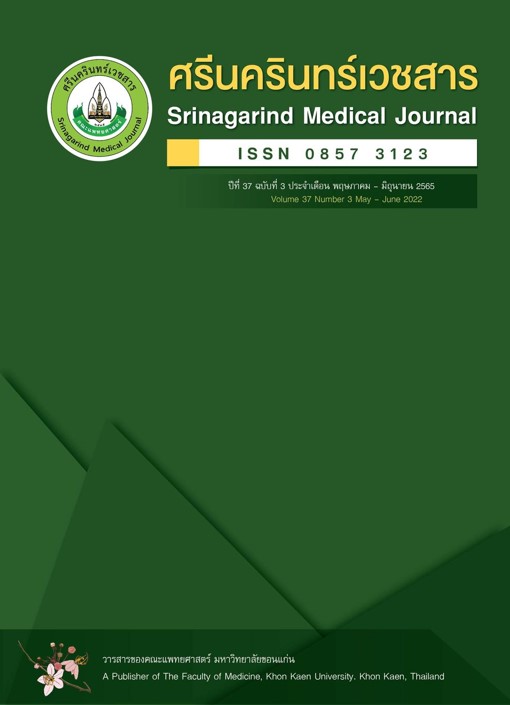The The Prevalence of Social-Media Related Working in Patients with Spinal Cord Injury
Keywords:
patients with spinal cord injury, prevalence, social media work-relatedAbstract
Background and Objectives: Patients with spinal cord injury commonly have the problem with restriction of body movement, this affects patients’s quality of life in many aspects especially the career aspect. The objectives of this study were to study the prevalence of social-media related working in patients with spinal cord injury and the related factors of social media that affect the employment status.
Methods: This study was a cross-sectional descriptive study.
Participants included spinal cord injury patients who was treated and followed up in rehabilitation department, Srinagarind hospital, Khon Kaen University between October 2020 - September 2021.
The data were collected from medical records of patients and interview; which consist of demographic data of participants and relative factors of social media that affect to employment status; statistical relationship was analyzed by using univariate regression analysis, the factors that have p value less than or equal 0.2 will be further analyzed by multivariate regression analysis.
Results: A total of 90 spinal cord injury patients were enrolled in this study. There were 18 patients (20 %) who had social media-related work, most of relating social media work were online merchants (77.8%). Having their own personal computer give them a chance of being employed 6.2-fold higher than those without (p=0.029; 95%CI, 1.2-32.24).
Conclusion: The prevalence of social media work-related in patients with spinal cord injury is 20% in this study. The related factor for employment status is having their own personal computer for access the social media.
References
Muangdan C, Pattanakuhar S, Ratanapinunchai J. Functional independence of patients with spinal cord injury and related factors after inpatient rehabilitation. J Thai Rehabil Med 2019;29:63–70.
Srisuppaphon D, Kharmwan S. Prevalence of Neuropathic Pain in Spinal Cord Injured Patients. J Thai Rehabil Med 2009;19:13-8.
Mueanchoo S, Chuawong P. Preparedness of Caregivers of Patients with Spinal Cord Injury. Journal of Phrapokklao Nursing College 2017;28:140–8.
Choochart N, Vichiansiri R, Arayawichanon P, Manimmanakorn N. Quality of Life of Traumatic Spinal Cord Injured Patients in North-East Region of Thailand. J Thai Rehabil Med 2015;25:15-21.
Wongsa S, Tongprasert S, Kovindha A. Quality of Life of Primary Caregivers of Disabled People with Spinal Cord Injury by using Short Form-36 Questionnaire. J Thai Rehabil Med 2011;21:28-33.
Leiulfsrud AS, Ruoranen K, Ostermann A, Reinhardt JD. The meaning of employment from the perspective of persons with spinal cord injuries in six European countries. Work Read Mass 2016;55:133–44.
Phanharach S, Manimmanakorn N, Kharmwan S. Factors Correlated Return to Work Ability of Spinal Cord Injured Patients after Rehabilitation in Srinagarind Hospital during 1997 - 2001. J Thai Rehabil Med 2006;16:44-51.
Vongpakorn P, Kovindha A. Employment Rate of Thais with Spinal Cord Injury and Predictive Factors. J Thai Rehabil Med 2014;24:28-36.
National labour information center (2014). 001_numbers of disabled person classified by employment status [Retrieved May 10, 2021]. Available from: https://bit.ly/35MCePr.
National labour information center (2014). 003_numbers of disabled person classified by occupation type. [Retrieved May 10, 2021]. Available from: https://bit.ly/3ckMfWJ.
Kemp S. (2020) Digital 2020 Global Digital Overview (January 2020) v01. [Retrieved May 20, 2020]. Available from: https://bit.ly/2Wm3mC1.
Electronics Transactions Development Agency (2020). e-Commerce (Electronic Commerce). [Retrieved February 21, 2022]. Available from: https://bit.ly/3LIHPtv.
Chaisiwamongkol W, Pattanakul K, Intharah T, Seenoi P, Maomeesri P, Kongkaew J. An Analysis of Influencing Factors for the Purchase Decision on E-commerce of Khon Kaen University Undergraduate Students. KKU Sci J 2019;47:339–52.
Kemp S. (2020). Digital 2020 Thailand (January 2020) v01. [Retrieved May 20, 2020]. Available from: https://bit.ly/2SRcEDO.
Office of the Royal Society. (2013). Social media (4 October 2013).[ Retrieved February 20, 2022]. Available from: https://bit.ly/3wKaZUL.
Huang IC. Employment outcomes following spinal cord injury in Taiwan. Int J Rehabil Res Int Z Rehabil Rev Int Rech Readaptation 2017;40:84–90.
Schwegler U, Nützi M, Marti A, Trezzini B, SwiSCI study group. Pre- and post-injury job type distributions of individuals with SCI in relation to structural changes in the labor market: A comparative analysis based on findings from the Swiss Spinal Cord Injury Cohort Study. J Spinal Cord Med 2021;44:77–88.
Rodrigues MPC, Araujo TCCF de. Internet as a support for people with spinal cord injuries: usage patterns and rehabilitation. Paideia Ribeirão Preto 2012;22:413–21.
O’Riley AA, Rose J, Dalal B. Online support for individuals with spinal cord injuries: an ethnographic investigation. J Spinal Cord Med 2014;37:179–85.
Houlihan BV, Drainoni ML, Warner G, Nesathurai S, Wierbicky J, Williams S. The impact of Internet access for people with spinal cord injuries: a descriptive analysis of a pilot study. Disabil Rehabil 2003;25:422–31.
Downloads
Published
How to Cite
Issue
Section
License
Copyright (c) 2022 Srinagarind Medical Journal

This work is licensed under a Creative Commons Attribution-NonCommercial-NoDerivatives 4.0 International License.




